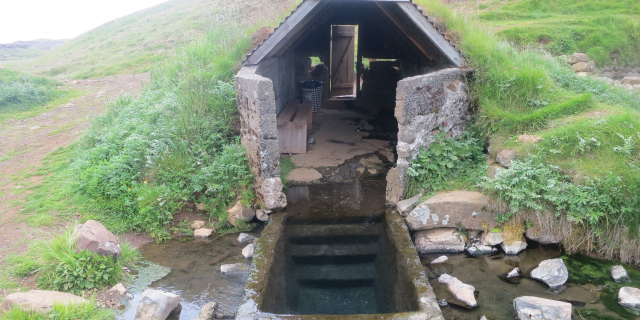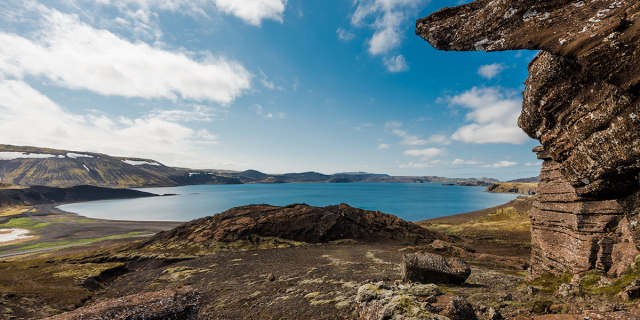Þingvellir (Icelandic: [ˈθiŋkˌvɛtlɪr̥] , anglicised as Thingvellir) was the site of the Alþing, the annual parliament of Iceland from the year 930 until the last session held at Þingvellir in 1798. Since 1881, the parliament has been located within Alþingishúsið in Reykjavík.
Þingvellir is now a national park in the municipality of Bláskógabyggð in southwestern Iceland, about 40 km (25 miles) northeast of Iceland's capital, Reykjavík. Þingvellir is a site of historical, cultural, and geological significance, and is one of the most popular tourist destinations in Iceland...Read more
Þingvellir (Icelandic: [ˈθiŋkˌvɛtlɪr̥] , anglicised as Thingvellir) was the site of the Alþing, the annual parliament of Iceland from the year 930 until the last session held at Þingvellir in 1798. Since 1881, the parliament has been located within Alþingishúsið in Reykjavík.
Þingvellir is now a national park in the municipality of Bláskógabyggð in southwestern Iceland, about 40 km (25 miles) northeast of Iceland's capital, Reykjavík. Þingvellir is a site of historical, cultural, and geological significance, and is one of the most popular tourist destinations in Iceland. The park lies in a rift valley that marks the crest of the Mid-Atlantic Ridge and the boundary between the North American and Eurasian tectonic plates. To its south lies Þingvallavatn, the largest natural lake in Iceland.
Þingvellir National Park (þjóðgarðurinn á Þingvöllum [ˈθjouðˌkarðʏrɪn au ˈθ iŋkˌvœtlʏm]) was founded in 1930, marking the 1000th anniversary of the Althing. The park was later expanded to protect the diverse and natural phenomena in the surrounding area and was designated as a World Heritage Site in 2004.
Þingvellir became a national park as a result of legislation passed in 1928 to protect the remains of the parliament site, thus creating the first national park in Iceland. The park was decreed "a protected national shrine for all Icelanders, the perpetual property of the Icelandic nation under the preservation of parliament, never to be sold or mortgaged."[1]
Founding of Iceland's parliamentAccording to the Book of Settlements (Landnámabók), the settlement of Iceland began in 874, when the Norwegian chieftain Ingólfr Arnarson became the first permanent Norwegian settler on the island.[2][3] Over the next centuries, people of Norse and Celtic origin settled in Iceland. Early on, district assemblies were formed, but as the population grew, there was a need for a general assembly. The descendants of Ingólfur who dominated the region of southwest Iceland had become the most powerful family in the country, and other chieftains felt a need for a general assembly to limit their power.
Grímur Geitskör was allotted the role of rallying support and finding a suitable location for the assembly. At about the same time, the owner of Bláskógar (the contemporary name for the Þingvellir region) was found guilty of murder. His land was declared public, and then obligated to be used for assembly proceedings, and the building of temporary dwellings, and the forest to be used for kindling and the grazing of horses. The Þingvellir area was chosen for this reason and its accessibility to the most populous regions of the north, south, and west.[4] The longest journey a goði (chieftain) had to travel was 17 days, from the easternmost part of the country where mountains and glacial rivers proved bothersome obstacles.[5]
The foundation of the Icelandic parliament is said to be the founding of the nation of Iceland, and the first parliamentary proceedings in the summer of 930 laid the ground for a common cultural heritage and national identity. Þingvellir played a central role in the history of the country, and its history runs almost parallel with the history of the Icelandic Commonwealth.
Panoramas From commonwealth to foreign rule Snorkeling in the Silfra canyon.
Snorkeling in the Silfra canyon. Scuba diver in the Silfra.
Scuba diver in the Silfra.The Alþingi (assembly) at Þingvellir was Iceland's supreme legislative and judicial authority from its establishment in 930 until 1271. The Lögberg or Law Rock was the focal point of the Alþingi and a natural platform for holding speeches. The Lawspeaker, elected for three years at a time, presided over the assembly and recited the law of the land. Before the law was written down, he was expected to recite it from memory on the Lögberg throughout three summers along with the complete assembly procedures every summer. Inauguration and dissolution of the assembly took place at the Lögberg, where rulings made by the Law Council were announced, the calendar was confirmed, legal actions were brought and other announcements made which concerned the entire nation. Anyone attending the assembly was entitled to present his case on important issues from the Lögberg.
The Law Council served as both parliament and supreme court. Laws were passed and approved there, and rulings were made on points of law. The Law Council appointed members of the Fifth Court (a kind of appellate court) and the Lawspeaker and took part in the election of the bishop. Unlike the Alþingi, the Law Council was a closed body in which only certain people enjoyed full rights: chieftains who held the office of goði, their Þingmen and later also bishops. However, everyone at the assembly was entitled to watch and listen to the Law Council at work.
From the earliest times until the 15th century, the Law Council met at Neðri-Vellir on the east bank of Öxará, but when the river changed its course around 1500, the council was moved to an islet in the river. In 1594, the Law Council was relocated to the foot of the ancient Law Rock, where it remained until the Alþingi was finally transferred from it in 1798.
The Alþingi was Iceland's legislative and chief judicial authority for the duration of the Commonwealth, until 1271. Executive power was in the hands of the chieftains and parties to individual cases. This proved to be quite an adequate arrangement for as long as the balance of power remained, but flaws emerged when it was disrupted.
In the final decades of the Commonwealth, there were clashes between chieftain families, which resulted in Iceland coming under the Norwegian crown. Executive power was strengthened under this new order, while legislative and judicial authority at first remained in the hands of the Alþingi, but was gradually transferred to the Norwegian and later the Danish rulers, until in 1662 when the King of Denmark became the absolute monarch of Iceland.
 Þingvellir covered in snowSocial centre
Þingvellir covered in snowSocial centre
Þingvellir was the centre of Icelandic culture. Every year during the Commonwealth period, people would flock to Þingvellir from all over the country, sometimes numbering in the thousands.
They set up temporary dwellings (búð [ˈpuːθ], pl. búðir [ˈpuːðɪr̥]) with walls of turf and rock and temporary roofing of homespun cloth, and stayed in them for the two weeks of the assembly. There were no permanent buildings on Þingvellir apart from a farm and, later, two churches.[6]
Although the duties of the assembly were the main reason for going there, ordinary people gathered at Þingvellir for a wide variety of reasons. Merchants, sword-sharpeners, and tanners would sell their goods and services, entertainers performed, and ale-makers brewed drinks for the assembly guests. News was told from distant parts; games and feasts were held. Young people met to make their plans, no less than leading national figures and experts in law. Itinerant farmhands looked for work and vagrants begged. Þingvellir was a meeting place for everyone in Iceland, laying the foundation for the language and literature that have been a prominent part of people's lives right up to the present day.[citation needed]
Nationalist symbolDuring the 19th century, Þingvellir emerged as a nationalist symbol.[7][8] According to Icelandic political scientist Birgir Hermannsson, "Thingvellir can be likened to a church or building which serves as a pilgrimage destination and as a site for the nation-state’s ritual ceremonies."[7]

































Add new comment